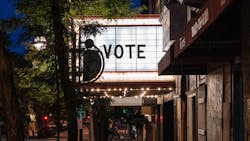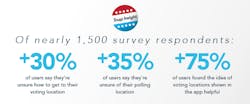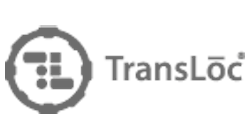Why public transit is key to boosting voter turnout
Presidential election years are a time when everyone seems to be talking about getting out to vote. From celebrity advertisements, to national advocacy campaigns, to local initiatives, it's hard to avoid the message that you should vote in November.
While awareness campaigns are all well and good, it’s important that we also take time to provide answers on how Americans can vote. Transportation is a huge part of this conversation and we’ve seen a number of initiatives where local nonprofits offer rides to the polls and ride-sharing services like Lyft and Uber offering discounted services for voting. What’s missing is how we use transit to improve voter access. A recent poll conducted through the TransLoc app found that 30 percent of transit riders still don’t know where to vote and another 30 percent don’t know how to get to their polling station. If we want to truly improve voter turnout, we need to create transportation options that easily fit into Americans’ daily routines.
Discounted Rides Don’t Remove Cost as a Barrier
Ride-sharing and other luxury services provide an easy way to travel, but come at a high cost. While a discount may be helpful for someone heading to a poll in their neighborhood, it might not be enough for the person who has to travel more than a few miles to reach their polling station. For someone with limited disposable income, even a few extra dollars for a ride could be a financial burden.
Public transit is the affordable option for voters, especially for those who may already have a monthly pass or subsidized fare for the service. To improve voter access, it's important that there is transparency between the local voting commission, the city and transit agencies to understand the proximity between polling locations and public transit routes. This can be done by identifying and promoting the polling locations that are already near fixed-route services. Beyond this, on-demand services can help people get from their homes to the local transit station and can even fill potential gaps between where a fixed route service ends and the location of the polling place.
Voting Shouldn’t Tax Citizens Daily Resources
Time is a huge factor in voter turnout, with many voters struggling to find the time to get to the polls between work, their family and other responsibilities. It takes time for a person to research candidates, to travel to the polls and to actually vote. It’s not that all 43 percent of eligible voters who didn’t go to the polls in 2016 didn’t want to. For some it may have simply been they had to choose between their job or family and voting. It’s time we change that.
Public transit is cemented into many people’s everyday routines and because of this, transit services have an opportunity to ease the burden of voting by providing information that helps Americans to exercise their civic duty. This is why at TransLoc, we are working with the Voting Information Project to make polling locations for early and day-of voting visible in our transit app, as well as ballot box locations. By identifying where people can vote, we are making it easier for them to include a stop by the polls into their daily commute to or from work or during other daily activities, such as picking their kids up from school. This allows voters to put the majority of their time toward candidate research and actually voting, rather than traveling to the polls.
Now More Than Ever, We Need Riders to Feel Safe
It's critical that riders feel protected on public transit. Concerns about health and safety could stop Americans from making the trip to vote if they don’t have a personal vehicle. To combat these emerging fears, transit agencies need to ensure they are creating safe spaces for riders by implementing technologies that offer contactless payments and passenger counters that help riders to maintain a safe social distance. As traffic on poll routes increase, transit agencies should schedule additional buses to increase the frequency of service and limit the chance that someone has to decide between taking a bus they feel is too crowded, and ultimately not voting.
The presidential election highlights current gaps in voter access that limit turnout and create a response of new programs that help people to get out and vote. However, we shouldn’t be thinking about access just once every four years. It’s important that we consider barriers to cost, time and safety for every election, community meeting or other local events. Public transit is a critical component to ensuring equitable access and building an infrastructure that can be used beyond November.
------------------------
Ben Haynie is vice president of product at TransLoc.

Ben Haynie | Vice President Product
Ben Haynie is vice president product at TransLoc.





